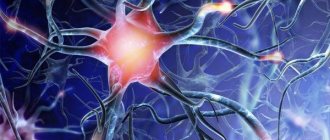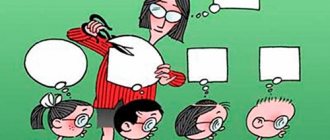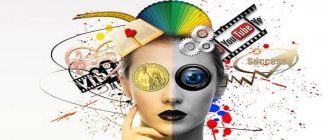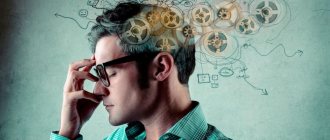The human brain is still the biggest mystery. However, thanks to the rapid development of neuroscience, we have learned to control his condition. Meditation and relaxation, developmental and intellectual exercises, neurofeedback training - all these are techniques aimed at training our brain. We tell you how it works and why it is needed. Olga Chashchina, psychotherapist, Ph.D., specialist in neurotechnology at X-Clinic, helped us understand the intricacies of this issue.
Exercise for the brain
Exercising your brain, like exercising your body, helps us stay young and energetic. When playing sports, muscle tissue is formed, the body becomes elastic and toned, approximately the same principle is observed when working with the brain: with regular exercise, new neural connections are formed, which affect psychological flexibility and the ability to adapt to different conditions. Moreover, as in the situation with the body, systematicity is an important condition for strong and sustainable health.
You can train your consciousness and brain in a variety of ways, for example, to improve concentration, puzzles, video games, various exercise equipment and speed reading are suitable. You can improve your memory and relieve stress through meditation and mindfulness practice. There are also methods that combine all this, based on the latest research in the field of neurophysiology, for example, neurofeedback training.
Restoration of brain functions in psychiatry and neurology
Despite the fact that the importance of executive functioning for mental activity is difficult to overestimate, the range of its components, in my opinion, is not clearly outlined. Executive function (EF) refers to a number of abilities, including problem solving, planning, initiation, self-control, conscious attention, the ability to cope with new situations, and the ability to change plans when necessary. This is a high cognitive function that is extremely important for a person and allows him to maintain daily activities while maintaining a good quality of life. The executive function domain is associated with associations of psychopathological symptoms, cognitive reserve, rating scales, and cognitive rehabilitation programs.
"Frontal syndrome" and "disexploitation syndrome"
In the past, when studying patients with prefrontal damage, researchers have noted specific impairments in several functions, such as initiation, sequencing, flexibility, monitoring, judgment, planning, decision making, and difficulty when faced with new tasks. At the time, this functional disorder was called "frontal lobe syndrome," although some of these patients had neurologically intact frontal lobes. The inability to control these cognitive functions then became known as Dysexecutive Syndrome (DS). In this sense, DS is not necessarily associated with frontal lobe injury, but rather with a range of deficits in processing, planning, initiating behavior, maintaining that behavior, self-regulation, and self-control.
Frontal functions
There are at least four categories that relate to frontal functions but are not necessarily caused by frontal lobe injuries: energization, executive cognition, behavioral/emotional self-regulation, and meta-cognition.
"Energization" or excitement
The process of the necessary tone for the initiation and maintenance of any (certain) response mode in foreign literature is designated by the term “energization”.
Executive cognitive functions
Planning, monitoring the sequence of actions when solving problems and regulating behavior are in some cases referred to as executive cognitive functions.
Self-regulation of behavior/emotions
Necessary for solving difficult situations caused by external triggers, the habits and skills of cognitive analysis allow a person to independently regulate their emotions and behavior.
Meta-cognitive process
Integration of cognitions and emotions, aspects of personality, social cognitions, self-awareness, and adequate perception of humor are components of the meta-cognitive process.
Executive functions in psychiatry
Executive deficits are seen in many mental disorders, including attention deficit hyperactivity disorder (ADHD), post-traumatic stress disorder (PTSD), schizophrenia, and bipolar disorder. In mood disorders, patients have cognitive impairment associated with frontal regions, demonstrating decreased performance in verbal memory, cognitive flexibility, coping, metacognition, and self-regulation, especially compared to healthy subjects. In fact, the disease requiring the most cognitive rehabilitation is schizophrenia, where significant loss of brain volume can occur. In addition, patients with schizophrenia demonstrated a significant decline in social skills, which increased the need for cognitive rehabilitation and, in particular, restoration of full executive functioning. These methods (cognitive remediation) must combine neurocognitive and psychosocial components, the results of which have shown a positive impact on the functioning of these people in everyday life.
Executive functions in addiction medicine
Substance use disorders are also associated with executive impairments such as loss of cognitive flexibility, difficulty making decisions, and processing speed. Again, here we have hypofrontality of brain structures and networks.
Executive functions in neuroscience
Impaired executive functioning is also associated with subcortical disorders, in particular Parkinson's disease, progressive supranuclear palsy, Huntington's disease, Korsakoff's syndrome and dementia caused by inhalation of organic solvents.
Brain recovery
In this sense, two concepts that have gained prominence in discussions among neuropsychologists are of interest: brain reserve and cognitive reserve. Cognitive and brain reserve can reduce the risk of maladaptive behavior because it relates to the brain's ability to actively cope with damage through cognitive processes.
Working with the “brain reserve”
“Brain reserve” generally refers to certain characteristics of the brain that can vary between individuals, including size, neurogenesis, neuronal density, and synaptic connections. Numerous studies provide evidence that brain reserve may be malleable, and suggest that regular cognitive exercises in particular can significantly benefit those with schizophrenia. Education increases the growth of synapses in an infant or child. In addition, the effect of virtual reality exercises on patients with traumatic brain injury shows an improvement in some cognitive indicators.
"Cognitive reserve"
"Cognitive reserve" refers to the brain's ability to cope with problems using other cognitive resources. As a consequence, two people with the same degree of structural brain reserve may adapt more or less successfully to brain injury if one has a greater amount of “cognitive reserve,” that is, a greater variety of cognitive processes to recruit or use as compensation. The neural implementation of “cognitive reserve” can be divided into “neural reserve” and “neural compensation”. The former refers to differentially effective synaptic communication patterns, while "neural compensation" refers to the recruitment of brain regions not typically used by people without brain pathology to compensate for brain damage.
Good cognitive reserve can aid in recovery and compensation for injury through both neural reserve and neural compensation. This allows us to think about the consequences of brain damage in terms of neuroplasticity and cognitive rehabilitation.
Once the possibility arises that DS problems are positively associated with some structural damage, people with brain reserve have a sort of "fat to burn" while those with cognitive reserve may cope better and find different ways to solve the problem. Supporting these findings, some evidence from people with high levels of activity, such as being creative, reading, visiting friends, going to movies and restaurants, walking, and doing physical and mental exercise, suggests that these people have a lower risk of developing dementia.
Other studies have shown that patients with a history of premorbid brain disease experienced greater post-traumatic cognitive decline. On the other hand, as mentioned earlier, mental disorders can damage brain reserve, as seen in schizophrenia, where gray matter loss can reach 3% of the total brain volume, specifically 3.5% in the frontal lobe.
Executive Function Assessment
To select the best therapeutic program for brain recovery in schizophrenia, a good neuropsychological assessment is necessary, based on three main goals: measurement, diagnosis and interpretation of each measurement. Neuropsychological tests must individually distinguish cognitive components (dimensions), such as planning or self-control separately, and then indicate where errors are concentrated (diagnosis). The last part of the assessment is to decide what the rehabilitation will focus on (interpretation).
A virtual reality
Another method of neuropsychological assessment that has clearly expanded in recent years is the use of virtual reality (VR), which has also been used for cognitive rehabilitation purposes.
Difficulty assessing executive functions
Making a neuropsychological diagnosis when a person is not functioning effectively—due to their impulsivity, inability to plan, or inability to maintain assigned tasks—is not always easy when it comes to self-report. Moreover, in practice, it may be difficult to identify all aspects associated with behavior problems due to poor self-report ability. For example: poor attention or specific working memory deficits are often the first symptoms to come to our attention. As a consequence, the person's self-control deteriorates and, consequently, the patient does not notice problems as they arise.
Ecological relevance of neuropsychological tests
In this sense, some neuropsychologists debate the ecological validity of a reasonable number of neuropsychological tests. By “ecological” we mean how representative the test is of the life of a particular person. Some authors have suggested that most tests do not illustrate true clinical findings; probably because these assessments do not occur in everyday life, but are observed separately in standardized (non-environmental) tests. The "zoo map" and the "multi-errand test" are two examples that have strong ecological value. Here the patient must simultaneously solve several problems. This requires planning ability as well as good management skills to handle all the tasks. The patient mixes simple tasks when doing a dual-task exercise, especially multiple assignments, due to error patterns. These tests are closer to the real world situation than other tests, which can be great EF tests, but not to the common behaviors we are used to implementing every day. The Behavioral Memory Test is another valid environmental test used to assess everyday memory problems and identify moderate to severe impairments, but minor memory impairments may go undetected here in some patients who score within the normal range.
Impulsiveness
Another manifestation of executive deficit may be impulsivity: for some patients, the problem is not so much the inability to look ahead or anticipate consequences, but rather the difficulty of inhibiting one's desires or impulses in response to changes in the external situation.
Rehabilitation programs
Modern rehabilitation programs consider functional assessment to be the most revealing. They analyze the patient's behavior in situations where there is a deficit and notice the exact stage at which the person breaks down. By focusing on gradually increasing the patient's autonomy, we will achieve a greater number of hits that can be achieved through cognitive rehabilitation. Virtual cognitive remediation programs are of particular interest. Virtual reality technology has been found to be a good treatment and assessment tool in several contexts. VR has been used as a way to improve the ecological validity of tests because a wide range of possibilities and situations can be simulated in a virtual world. Instead of simulating normal activities, V-STORE simulates a store where patients must pick up groceries from a Virtual Action-Planning Supermarket, simulating everyday running of errands.
The goal of every executive rehabilitation program should be to improve or provide greater autonomy to individuals in everyday situations, allowing them to solve problems (within their capabilities) rather than getting stuck in a vicious cycle in which executive skills are not used.
Basically, rehabilitation programs for prefrontal disorders can be divided into four areas (see above).
Working memory
In the context of prospective memory, retraining is a technique in which the client performs a specific action repeatedly with increasing periods of time between each action. This interval search is a useful and well-known method for learning information. As long as this is successful, we can strengthen retrospective memory to provide the necessary support for future memory. This method is very useful for people with Alzheimer's disease to complete a daily prospective memory task displayed on a calendar (Fish et al., 2009). In addition, it can support the executive component using free pathways or integrative approaches aimed at increasing awareness of difficulties and increasing the use of compensatory strategies.
Supervision of attention
Since the development of the supervisory attention system (SAS) model, it has become clear that everyday functioning is a highly complex and dynamic interaction of automatic routine behavior and consciously controlled action.
Meditation
There are many different meditation techniques, but let's focus on the most seemingly simple one - sit in silence with your eyes closed, focusing on your breathing. Even such a seemingly simple exercise can cause a lot of obstacles. For the first time, it will be extremely difficult to sit for even a minute without annoying thoughts overwhelming your consciousness. However, by gradually stopping your stream of consciousness and returning to your breathing, you will help your brain reset. Daily practices help to get rid of anxiety, reduce the impact of stress and learn to control attention.
Research shows that those who practice meditation every day have a thicker layer of gray matter in precisely those areas that are responsible for attention and psychological flexibility. Training your brain through meditation means that over time you need to put less and less effort into focusing your attention. This means that over time it will become easier for you to concentrate in everyday life when it is necessary - for example, at an important meeting or taking an exam.
Experiment at work
We enjoy working on something new. But doing the same thing for a long time, interest in it gradually fades, we begin to complete tasks more slowly and without enthusiasm. However, you can learn to produce dopamine on your own and get satisfaction from an already boring task. To do this, you need to regularly experiment in your work: for example, perform routine tasks using a new method, change the daily schedule, swapping your usual duties, try to optimize processes using time management methods.
The cause of decreased productivity may also be due to ineffective time management. For example, you work a lot, but as a result you complete one or two tasks per day. Take a free online course on Time Management. From the course you will learn how to determine what your resources are spent on and how to correctly distribute them in order to get everything done to the maximum, how to live in pleasure and without stress.
Online trainers and games
Crossword puzzles and printed Sudoku have been replaced by online services for brain development and training. You can choose anything from online puzzles to educational games that analyze your gaming behavior and adapt to your decisions. The most popular are Vikium, Uplift and Bitreynika. What is it for? First of all, doing exercises can just be fun. Secondly, it allows you to escape from everyday stressful situations with health benefits. From a pragmatic point of view, such exercises improve cognitive abilities, which over time will help you solve life and work problems faster, remember the names of colleagues and acquaintances, and remember important family dates.
Pomodoro method
The method was developed by student Francesco Cirillo; he came up with an interesting name thanks to a timer in the shape of a tomato. To increase productivity and not constantly switch to small tasks, you need to set yourself a rule - work for 25 minutes, rest for 5 minutes. After an hour of work, take a long break for 15-20 minutes. You can adjust the time to suit your needs, for example, set aside 50-60 minutes for tasks, and leave 10 minutes for a break. You can learn more about the Pomodoro technique from our previous article.
Neurofeedback training
One of the promising methods is neurofeedback training. This is a procedure that allows you to learn to control the activity of your own brain. It is based on the principle of biofeedback. During neurofeedback training, small electrical signals from the brain are measured using electrodes attached to the scalp and converted into sound and images using software. That is, a computer program creates a real-time visualization of the bioelectrical activity of the brain.
How does this happen
The doctor gives instructions - and if the brain rhythms indicate a transition to the desired therapeutic state, then the program on the screen changes the image, sound and vibration intensity of the tactile sensor. Feedback facilitates the process of learning physiological control, and the computer program makes available information that would normally be imperceptible. If necessary, the doctor uses additional techniques to control the emotional state in order to enhance the effect of neurofeedback training.
It turns out that you can influence the rhythms of the brain interactively by tracking and recording your sensations. As you continue training and consolidate the desired feeling of relaxation, you acquire the skill of moving into the necessary therapeutic state on your own at any time.
Source: https://www.beicon.ru/beauty/trenirovki-dlya-mozga-kakie-oni-bivayut-i-zachem-oni-nuzhni-soveti-specialista
Back to list
Habit 1. Spend the morning so that your brain invigorates
We assign a daily routine
It is impossible to maintain a youthful brain if life is extremely monotonous. However, there is something that is better not to change at all. This is the daily routine.
You need to wake up every morning at about the same time, then spend some time in the sun. Try to do the most important things at the moment of greatest brain activity, and in the evening go to bed as early as possible. If you constantly adhere to approximately this schedule, your brain will work more stable. And this is very important for everyone.
You probably know about jet lag. This is a condition when the brain’s operating mode ceases to coincide with the daily routine. You need to act, but you can’t, because your brain is used to sleeping at this time, and vice versa - you want to go to bed, but you can’t fall asleep.
This is roughly how the brain feels when the daily routine is disrupted. The only way to fix this is to create a starting point in your daily life.
Neglect of daily routine is a direct road to dementia, and this is not an exaggeration.
Making the brain work
If you wake up at a certain time and stand in the sun for a little while, then the brain will somehow also switch into working mode (the human and animal body checks its internal clock with the intensity of sunlight). However, it cannot be said that from that moment the brain fully woke up.
You've probably heard that it begins to work actively only two hours after waking up, and if you are going to take an exam, you need to get up at least two hours before entering the classroom. But if these two hours differ little in activity from sleep, then this will not give the desired results.
Just like the body, the brain needs to warm up. A morning warm-up that includes a load on the primary functions of the brain is a great way to wake up the areas responsible for thinking.
If you wake up every morning shortly before leaving the house, take the subway or train without walking even ten minutes, and spend the entire working day at the computer, then try to wake up early and do a couple of things from this list:
- walking or other light physical activity;
- cleaning the room;
- cooking;
- plant care;
- simple dialogue with someone (greeting, exchanging a couple of remarks);
- reading aloud (if possible, at least 10 minutes).
Chatting or reading aloud
Lately there has been a lot of talk that reading aloud is very useful. This is true, because this process involves not only the eyes and speech apparatus, but also working with information (perception - processing - reproduction). When we read a text silently, some passages may remain unclear, but to read aloud, we need to delve into the content. This is precisely the information processing stage. Pronouncing the text is the stage of its reproduction.
Morning training has a good effect on the speed of visual perception of information, and on hearing, and on the ability to express one’s thoughts without hesitation, including in writing. To give an example from sports, it is similar to simple team exercises.
Constantly reading aloud will be especially useful for those who communicate little with people. When you read the text, it’s better not to just say it, but imagine it as if you were doing it to someone else.
Summary:
- Compliance with the regime is important for stable brain function.
- To do this, you need to create a starting point: always get up at the same time.
- Warm-up is also important for the brain. You need to move and talk.
Gotu kola
Asian centella, which is called “gotu kola” in its homeland, India, is literally the twin sister of the famous Chinese giant ginkgo. The juice of its leaves has a similar stimulating effect on the brain, thanks to its unique terpene-glycoside composition. Local residents discovered the unique properties of gotu kola by observing the behavior of Indian elephants: the animals always willingly grazed in the thickets of centella, and elephants are distinguished by a high level of intelligence and long life expectancy.
Gotu kola is also an excellent blood circulation stimulant, so it is recommended for thrombophlebitis, varicose veins and cellulite. Taking centella extract helps to activate the production of choline and acetylcholine, the important function of which we have already talked about a lot above. In Thailand, a large study of gotu kola was conducted in 2008 with a group of elderly patients. The results showed significant improvements in overall well-being, mood, concentration and memory.
More details:
10 beneficial properties of gotu kola, instructions
Creatine
Creatine belongs to the group of nitrogen-containing organic acids and is synthesized in the body of all mammals, including humans. If you artificially increase the concentration of this beneficial substance, you can accelerate cellular reactions, enhance muscle growth and increase the threshold of fatigue. A great combination of effects for athletes and bodybuilders, isn't it? This is why creatine, as a dietary supplement, is very popular in the sports community.
But today we are interested in the nootropic status of creatine. Those who want to “pump up” their brain will also find this nutrient useful, since it has an energy-saving effect on the brain. Creatine participates in reactions taking place in mitochondria and cytosol, and promotes the accumulation and conservation of energy in cells. The result is good memory and high speed of analytical thinking. It is recommended to take 5 g of creatine daily unless otherwise prescribed by your doctor.











